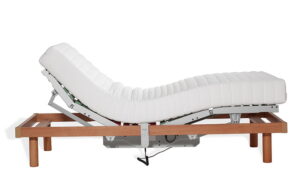Overview – Back Pain

Back pain is one of the leading causes of disability worldwide. It’s also one of the most common reasons why people cannot continue working. The pain is so common that it’s been called “the New Normal”.
This type of discomfort can be caused by several number of factors, including an unhealthy lifestyle and genetics. You may have Degenerative Disc Disease. If so, the options below may be of help, but we recommend you see your medical provider as well.
Exercise

Exercise is one of the most effective ways to avoid health issues. Regularly exercising can strengthen your muscles, improve your posture and prevent future discomfort or pain.
When it comes to your spine, it’s best to avoid certain exercises that may irritate it, such as lifting heavy weights. Rather, focus on efforts that can strengthen your spine and core muscles, such as yoga, Pilates, walking, and swimming.
Also, consider gentle stretches in your daily routine. Exercising regularly can also help in managing stress, which can play an integral part in triggering the pain and discomfort you may be feeling.
Additionally, it’s important to consider the type of shoes you wear and what impact they may have on your posture and health.
Identify the Cause of Your Pain
If you can, pin down why you are having this discomfort. Is it from a previous injury or sports-related? Or are you just waking up feeling this in the morning?
Whatever it can be targeted to, it can help you determine the best course of action for treating your pain. Additionally, some common causes include a weak core, bad posture, poor sleeping habits, incorrect lifting techniques, and spinal injuries.
If you suffer from frequent or recurring pain, you should visit your doctor to determine the cause and get the proper treatment and management plan. If you have on-off episodes of pain, you may be able to treat it on your own at home.
Breathe and Relax

Relaxation exercises help reduce stress, which often plays a part in triggering pain or discomfort in the spine. Additionally, deep breathing can help improve your posture.
To do deep breathing exercises, find a quiet place to sit, relax your muscles, and focus on your breathing.
You can also do this lying down or even while you’re walking! By taking a few minutes every day to focus on these techniques, you may at the very least, feel a little better. These exercises help with mental stimulation as well.
Get a Professional Massage or Bodywork

Most people would jump at the suggestion to get a massage and why not? Regularly receiving massage therapy or other types of bodywork is another excellent home remedy for many types of pain-related ailments.
These treatments can help improve your flexibility and range of motion. If you suffer from frequent or recurring pain, you could visit a massage therapist or bodywork practitioner to help manage your pain and discomfort.
Massage treatments may provide short-term pain relief, but they are not long-term treatment plans. It’s also important to consider the type of massage you receive. Deep tissue massage and myofascial release therapy are two types of massage that may be beneficial for managing spine-related pain.
Make a Scheduled Commitment to Stretching
 Regularly making a committed effort to stretch and relax your muscles can help you as well. There are many different stretches you can perform to target different areas of your body and promote flexibility.
Regularly making a committed effort to stretch and relax your muscles can help you as well. There are many different stretches you can perform to target different areas of your body and promote flexibility.
For your spine, try lying face-down on the floor and pulling both knees towards your chest, gently extending your arms out in front of you. You can also try sitting in a chair with both feet flat on the ground and slowly leaning back, keeping it straight, and extending your arms straight out so that they are parallel with the floor. Remember that regimens of stretching and relaxation are best performed slowly and gently.
Lay on a Heat-Filled Blanket
Feeling the warmth from a heated blanket can provide you with both a comforting feeling and the added benefit of soothing your vertebrae and muscles.
A heated blanket can help improve blood flow and circulation, which can, in turn, alleviate pain. If you have a heated blanket, simply turning it up to a high temperature will suffice.
Note that using a heated blanket is not recommended while you’re asleep. Doing so may disrupt your sleep, which is not a good idea if you are experiencing pain. Instead, try doing this for about 15 minutes before bedtime.
There are a variety of counter-heating remedies, such as heating pads available at your local retail store.
What is Your Mattress Like?
Studies have shown that a poor or old mattress may be a factor in back pain, especially if you have Degenerative Disc Disease. The reason is that a bad mattress will cause your body to exert pressure on the damaged discs, resulting in the pain you feel in the morning when you wake up.

A new mattress that allows your body to ‘sink’ in can relieve some of the pressure on the discs. Additionally, consider getting a mattress base that can move up and down. With this option, you can push a button and the base at your feet will rise, providing reduced pressure on your body, especially the lumbar area where the discs reside.
We know buying a new mattress along with a movable base can get expensive, but it is will be well worth it if you see that your pain has subsided. Many mattress companies give you a 30-day option to try it out and return it if it is not working for you.
Try TENS
TENS, which stands for transcutaneous electrical nerve stimulation delivers small electrical impulses to your body to help with the pain and discomfort associated with pain.
There are many different TENS machines available, so it’s important to do your research to find the best one for you, as well as confer with your doctor. TENS machines are particularly useful for managing pain that is caused by injuries or surgeries.
If you’re experiencing ongoing pain and discomfort, using a TENS machine can help reduce your pain and make your daily life easier. While these machines are effective, they are not FDA-approved for the treatment of this type of discomfort. That being said, they are often used to manage pain and reduce inflammation.
Of course, you should consult with a pain specialist before acquiring this apparatus yourself.
Bottom line
These are potential remedies you can try to reduce or eliminate pain in your vertebrae. It includes exercise and sleep, eating a balanced diet, managing your stress levels, and reviewing your mattress.
If you are in severe pain or the pain continues, you should seek the assistance of a physician. Even if the pain is not severe or constant, it wouldn’t hurt to see medical advice as well.
